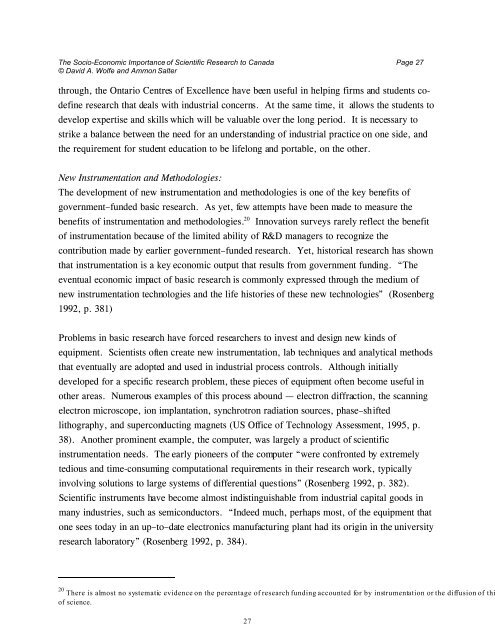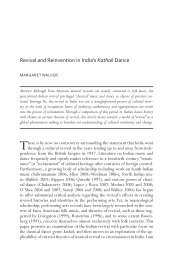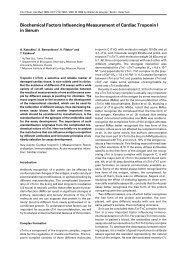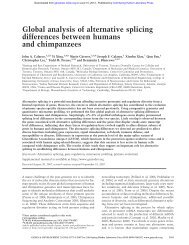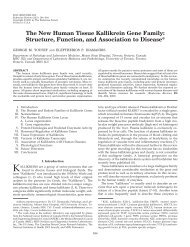The Socio-Economic Importance of Scientific Research To Canada
The Socio-Economic Importance of Scientific Research To Canada
The Socio-Economic Importance of Scientific Research To Canada
You also want an ePaper? Increase the reach of your titles
YUMPU automatically turns print PDFs into web optimized ePapers that Google loves.
<strong>The</strong> <strong>Socio</strong>-<strong>Economic</strong> <strong>Importance</strong> <strong>of</strong> <strong>Scientific</strong> <strong>Research</strong> to <strong>Canada</strong> Page 27© David A. Wolfe and Ammon Salterthrough, the Ontario Centres <strong>of</strong> Excellence have been useful in helping firms and students codefineresearch that deals with industrial concerns. At the same time, it allows the students todevelop expertise and skills which will be valuable over the long period. It is necessary tostrike a balance between the need for an understanding <strong>of</strong> industrial practice on one side, andthe requirement for student education to be lifelong and portable, on the other.New Instrumentation and Methodologies:<strong>The</strong> development <strong>of</strong> new instrumentation and methodologies is one <strong>of</strong> the key benefits <strong>of</strong>government–funded basic research. As yet, few attempts have been made to measure thebenefits <strong>of</strong> instrumentation and methodologies. 20 Innovation surveys rarely reflect the benefit<strong>of</strong> instrumentation because <strong>of</strong> the limited ability <strong>of</strong> R&D managers to recognize thecontribution made by earlier government–funded research. Yet, historical research has shownthat instrumentation is a key economic output that results from government funding. “<strong>The</strong>eventual economic impact <strong>of</strong> basic research is commonly expressed through the medium <strong>of</strong>new instrumentation technologies and the life histories <strong>of</strong> these new technologies” (Rosenberg1992, p. 381)Problems in basic research have forced researchers to invest and design new kinds <strong>of</strong>equipment. Scientists <strong>of</strong>ten create new instrumentation, lab techniques and analytical methodsthat eventually are adopted and used in industrial process controls. Although initiallydeveloped for a specific research problem, these pieces <strong>of</strong> equipment <strong>of</strong>ten become useful inother areas. Numerous examples <strong>of</strong> this process abound — electron diffraction, the scanningelectron microscope, ion implantation, synchrotron radiation sources, phase–shiftedlithography, and superconducting magnets (US Office <strong>of</strong> Technology Assessment, 1995, p.38). Another prominent example, the computer, was largely a product <strong>of</strong> scientificinstrumentation needs. <strong>The</strong> early pioneers <strong>of</strong> the computer “were confronted by extremelytedious and time-consuming computational requirements in their research work, typicallyinvolving solutions to large systems <strong>of</strong> differential questions” (Rosenberg 1992, p. 382).<strong>Scientific</strong> instruments have become almost indistinguishable from industrial capital goods inmany industries, such as semiconductors. “Indeed much, perhaps most, <strong>of</strong> the equipment thatone sees today in an up–to–date electronics manufacturing plant had its origin in the universityresearch laboratory” (Rosenberg 1992, p. 384).20 <strong>The</strong>re is almost no systematic evidence on the percentage <strong>of</strong> research funding accounted for by instrumentation or the diffusion <strong>of</strong> thi<strong>of</strong> science.27


